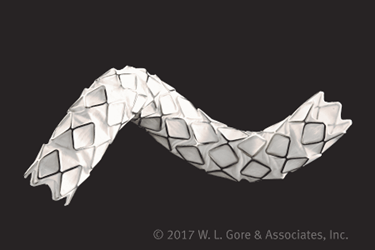Gore's Balloon Stent Graft First To Gain FDA Approval For PAD In Iliac Artery

FDA announced approval of W.L. Gore & Associates’ expandable balloon stent graft for treatment of peripheral artery disease (PAD) lesions in the iliac artery and at the aortic bifurcation. It is the first technology of its kind approved for this expanded indication. In clinical studies, the Gore Viabahn VBX Balloon Expandable Endoprosthesis (VBX Stent Graft) demonstrated immediate and nine-month safety and efficacy endpoints in a variety of challenging peripheral artery disease (PAD) presentations.
Iliac artery stenosis (narrowing) or occlusion (blockage) can be treated with anticoagulants or with more aggressive surgical interventions. Some balloon stent grafts that are indicated for different arteries are currently used by physicians off-label to treat iliac artery stenosis and occlusions in patients who cannot tolerate open surgery. Common complications include stent dislodgement and changes in device length.
With approval from FDA, the VBX Stent Graft is the first expandable balloon endoprosthesis indicated for iliac artery stenosis and occlusive disease. Its specialized design offers several proven advantages, according to Jean Bismuth, a vascular specialist at Houston Methodist and primary investigator of the Gore VBX Flex IDE clinical study.
“Overall, there were multiple clinical benefits observed, including no median change in the device length upon deployment and a 100 percent technical success rate with no occurrences of stent dislodgement or significant residual stenosis,” said Bismuth, in a press release. “The study device performed well in disadvantaged lesions, including occlusions, which speaks to its trackability, radial strength, conformability and stent retention.”
In a clinical study, the VBX Stent Graft was tested in 134 patients with varying presentations of the disease. Thirty two percent of participants had TASC II Type C or D lesions, for which the Trans-Atlantic Inter-Society Consensus Document (TASC) recommends open surgery, and 18 percent of patients required contralateral access to the lesion. Forty-two percent of participants required kissing stents at the aortic bifurcation.
In 134 patients, there were zero incidences of device-related adverse events, and there was a 100 percent success rate in device delivery and reducing target lesions to less than 30 percent of the original stenosis. The stent also demonstrated over 95 percent primary patency at nine months, including patients with TASC II C and D lesions traditionally deemed inappropriate for endovascular intervention.
“The VBX Stent Graft demonstrated notable immediate and nine-month safety and efficacy in treating patients with iliac occlusive disease which can be attributed to the exceptional device design,” said Bismuth.
The VBX is available in a variety of sizes, including diameters ranging from 5 to 11 millimeters and lengths of 15, 19, 29, 39, 59, and 79 millimeters. Because the graft does not require pre-dilation, clinicians can reduce the number of balloons used, and the choice in lengths reduces the need for multiple stents per lesion. Both factors, said a Gore spokesman, reduce costs.
Gore recently announced FDA 510(k) clearance for the Gore Synecor biomaterial indicated for single-stage hernia repair. The technology is appropriate in open, laproscopic, and robotic procedures and features non-porous film that minimizes tissue adhesion and a tissue scaffold providing rapid vascularization.
